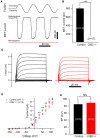Loss of CIB2 Causes Profound Hearing Loss and Abolishes Mechanoelectrical Transduction in Mice
- PMID: 29255404
- PMCID: PMC5722843
- DOI: 10.3389/fnmol.2017.00401
Loss of CIB2 Causes Profound Hearing Loss and Abolishes Mechanoelectrical Transduction in Mice
Abstract
Calcium and integrin-binding protein 2 (CIB2) belongs to a protein family with four known members, CIB1 through CIB4, which are characterized by multiple calcium-binding EF-hand domains. Among the family members, the Cib1 and Cib2 genes are expressed in mouse cochlear hair cells, and mutations in the human CIB2 gene have been associated with nonsyndromic deafness DFNB48 and syndromic deafness USH1J. To further explore the function of CIB1 and CIB2 in hearing, we established Cib1 and Cib2 knockout mice using the clustered regularly interspaced short palindromic repeat (CRISPR)-associated Cas9 nuclease (CRISPR/Cas9) genome editing technique. We found that loss of CIB1 protein does not affect auditory function, whereas loss of CIB2 protein causes profound hearing loss in mice. Further investigation revealed that hair cell stereocilia development is affected in Cib2 knockout mice. Noticeably, loss of CIB2 abolishes mechanoelectrical transduction (MET) currents in auditory hair cells. In conclusion, we show here that although both CIB1 and CIB2 are readily detected in the cochlea, only loss of CIB2 results in profound hearing loss, and that CIB2 is essential for auditory hair cell MET.
Keywords: CIB2; Usher syndrome; hearing loss; knockout mice; mechanoelectrical transduction; stereocilia.
Figures







Similar articles
-
CIB2 and CIB3 Regulate Stereocilia Maintenance and Mechanoelectrical Transduction in Mouse Vestibular Hair Cells.J Neurosci. 2023 May 3;43(18):3219-3231. doi: 10.1523/JNEUROSCI.1807-22.2023. Epub 2023 Mar 31. J Neurosci. 2023. PMID: 37001993 Free PMC article.
-
CIB2, defective in isolated deafness, is key for auditory hair cell mechanotransduction and survival.EMBO Mol Med. 2017 Dec;9(12):1711-1731. doi: 10.15252/emmm.201708087. EMBO Mol Med. 2017. PMID: 29084757 Free PMC article.
-
Alterations of the CIB2 calcium- and integrin-binding protein cause Usher syndrome type 1J and nonsyndromic deafness DFNB48.Nat Genet. 2012 Nov;44(11):1265-71. doi: 10.1038/ng.2426. Epub 2012 Sep 30. Nat Genet. 2012. PMID: 23023331 Free PMC article.
-
Advances in genetic hearing loss: CIB2 gene.Eur Arch Otorhinolaryngol. 2017 Apr;274(4):1791-1795. doi: 10.1007/s00405-016-4330-9. Epub 2016 Oct 22. Eur Arch Otorhinolaryngol. 2017. PMID: 27771768 Free PMC article. Review.
-
Calcium- and Integrin-Binding Protein 2 (CIB2) in Physiology and Disease: Bright and Dark Sides.Int J Mol Sci. 2022 Mar 24;23(7):3552. doi: 10.3390/ijms23073552. Int J Mol Sci. 2022. PMID: 35408910 Free PMC article. Review.
Cited by
-
Preferential Binding of Mg2+ Over Ca2+ to CIB2 Triggers an Allosteric Switch Impaired in Usher Syndrome Type 1J.Front Mol Neurosci. 2018 Aug 17;11:274. doi: 10.3389/fnmol.2018.00274. eCollection 2018. Front Mol Neurosci. 2018. PMID: 30174586 Free PMC article.
-
Ankyrin Is An Intracellular Tether for TMC Mechanotransduction Channels.Neuron. 2020 Jul 8;107(1):112-125.e10. doi: 10.1016/j.neuron.2020.03.026. Epub 2020 Apr 22. Neuron. 2020. PMID: 32325031 Free PMC article.
-
The actin cytoskeleton in hair bundle development and hearing loss.Hear Res. 2023 Sep 1;436:108817. doi: 10.1016/j.heares.2023.108817. Epub 2023 May 26. Hear Res. 2023. PMID: 37300948 Free PMC article. Review.
-
Structures of the TMC-1 complex illuminate mechanosensory transduction.Nature. 2022 Oct;610(7933):796-803. doi: 10.1038/s41586-022-05314-8. Epub 2022 Oct 12. Nature. 2022. PMID: 36224384 Free PMC article.
-
The Rho GTPase Cell Division Cycle 42 Regulates Stereocilia Development in Cochlear Hair Cells.Front Cell Dev Biol. 2021 Oct 22;9:765559. doi: 10.3389/fcell.2021.765559. eCollection 2021. Front Cell Dev Biol. 2021. PMID: 34746154 Free PMC article.
References
-
- Blazejczyk M., Sobczak A., Debowska K., Wisniewska M. B., Kirilenko A., Pikula S., et al. . (2009). Biochemical characterization and expression analysis of a novel EF-hand Ca2+ binding protein calmyrin2 (Cib2) in brain indicates its function in NMDA receptor mediated Ca2+ signaling. Arch. Biochem. Biophys. 487, 66–78. 10.1016/j.abb.2009.05.002 - DOI - PubMed
LinkOut - more resources
Full Text Sources
Other Literature Sources
Molecular Biology Databases
Miscellaneous

